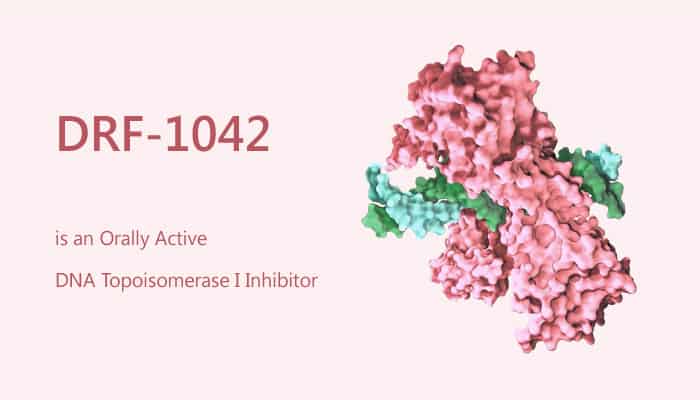Inhibitors of the enzyme topoisomerase I are cytotoxic for tumor cells because of their ability to cause DNA damage. Specifically, DNA Topoisomerase I (Top1) is one main cellular factor controlling topological homeostasis. Top1 activity can relax negative supercoils by cutting one of the DNA strands. This can create a transient Top1-DNA cleavage complex (Top1cc), and perform a controlled rotation of the cut strand around the uncut strand. Furthermore, persistent depletion of Top1 in mammalian cells leads to replicative stress and replication-transcription conflicts. Finally, stabilization of Top1cc by Top1 inhibitors such as camptothecin and its derivatives leads to R-loop stabilization in human cells upon short treatment. Besides, Camptothecin (CPT), an alkaloid first isolated from the Chinese tree Camptotheca acuminate, is a topoisomerase I inhibitor. DRF-1042 is an orally active derivative of Camptothecin and acts to inhibit DNA topoisomerase I with good anticancer activity.
DRF-1042 is an orally active derivative of Camptothecin. In addition, DRF-1042 acts to inhibit DNA topoisomerase I. Moreover, DRF-1042 shows good anticancer activity against a panel of human cancer cell lines including multi-drug resistance (MDR) phenotype. Furthermore, DRF-1042 demonstrated superior lactone stability and good in vitro anticancer activity against a panel of human cancer cell lines. The hollow fiber studies in animals with DRF-1042 treatment showed favorable bioavailability, tolerance, and significant anti-cancer activities against a panel of human cancer cell lines. Nonetheless, in clonogenic assay against murine, canine and human bone marrow cells, DRF-1042 treatment showed less myelosuppression. All in all, DRF-1042 represents a new class of CPT analogue-well-tolerated, orally active molecules with good therapeutic potential for the treatment of cancer.

References:
Sriram Rajagopal, et al. Published April 2004.